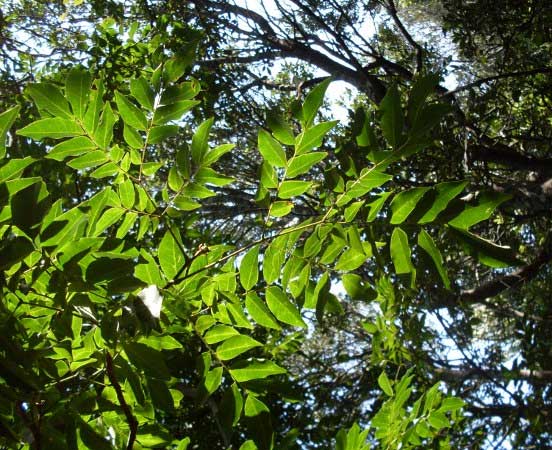
Pararchidendron pruinosum
Classification System: APG IV
Superregnum: Eukaryota
Regnum: Plantae
Cladus: Angiosperms
Cladus: Eudicots
Cladus: Core eudicots
Cladus: Rosids
Cladus: Eurosids I
Ordo: Fabales
Familia: Fabaceae
Subfamilia: Caesalpinioideae
Tribus: Ingeae
Genus: Pararchidendron
Species: Pararchidendron pruinosum
Varieties: P. p. var. junghuhnianum – P. p. var. pruinosum
Name
Pararchidendron pruinosum (Benth.) I.C.Nielsen
References
Bulletin du Museum National d'Histoire Naturelle. Section B, Adansonia: Botanique Phytochemie 5(3):328. 1984 ("1983")
USDA, ARS, Germplasm Resources Information Network. Pararchidendron pruinosum in the Germplasm Resources Information Network (GRIN), U.S. Department of Agriculture Agricultural Research Service. Accessed: 07-Oct-06.
Pararchidendron pruinosum is an Australian rainforest tree growing from the Shoalhaven River (34° S) in New South Wales to Herberton (17° S) in north Queensland. It is also found in New Guinea and, Indonesia. Common names include Snow-wood, Tulip Siris and Monkey's Earrings. The habitat of the Snow-wood is tropical, sub-tropical, warm temperate, littoral and riverine rainforest. Like most legume species, it fixes atmospheric nitrogen in the soil via its symbiotic partnership with root bacteria - trading the bacteria starches in exchange for nitrogen. It can be seen growing on sand within earshot of Seven Mile Beach, New South Wales.
Description
Snow-wood is a small to medium-sized tree, reaching 15 metres in height and a 35 cm in trunk diameter. The reddish trunk and lacy pinnate leaves give a pleasing appearance.
The trunk of Pararchidendron pruinosum is cylindrical, and not buttressed at the base. The bark is dark reddish brown patterned with corky pustules.
Leaves
The leaves are alternate and bipinnate. The main leaf stalk has one to three pairs of secondary leaf stalks, opposite or nearly so on the main stalk. Five to eleven leaflets alternatively arranged on the secondary leaf stalks. Leaves entire, lanceolate, four to five cm long, 13 to 20 mm broad. The tip tapers to a point, the leaf base is oblique. Smooth and green both surfaces, slightly paler below. Leaf venation is obvious, with a raised midrib evident on both upper and lower sides.
Flowers and fruit
Flowers fluffy white or greenish, fragrant, though later turning yellow. Flowering period is from October to January.
The fruit pod matures from February to June. Resembling Acacia fruit pods. Very twisted, and flattened. Seeds are black, shiny and mostly flat, oval in shape. Scarification of the seeds is advised to assist germination, which is slow but fairly reliable.
drawing by Margaret Flockton
References
iconTrees portal
Floyd, A.G., Rainforest Trees of Mainland South-eastern Australia, Inkata Press 1989, ISBN 0-909605-57-2
Retrieved from "http://en.wikipedia.org/"
All text is available under the terms of the GNU Free Documentation License

